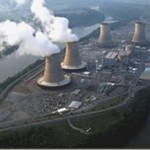 As a young mother of two daughters, both under 4, there were days when the world seemed a scary place. March 28, 1979 was one of those days. At 4am that March morning, an event took place that changed the way we felt about nuclear power. Suddenly, it became just a little bit dangerous. We were used to power plants, and they had never seemed like anything that could cause great harm. All that changed on March 28, 1979, when a pressure valve in the Unit-2 reactor at Three Mile Island failed to close. Cooling water, contaminated with radiation, drained from the open valve into adjoining buildings, and the core began to dangerously overheat. It was the worst accident in the history of the United States nuclear power industry.
As a young mother of two daughters, both under 4, there were days when the world seemed a scary place. March 28, 1979 was one of those days. At 4am that March morning, an event took place that changed the way we felt about nuclear power. Suddenly, it became just a little bit dangerous. We were used to power plants, and they had never seemed like anything that could cause great harm. All that changed on March 28, 1979, when a pressure valve in the Unit-2 reactor at Three Mile Island failed to close. Cooling water, contaminated with radiation, drained from the open valve into adjoining buildings, and the core began to dangerously overheat. It was the worst accident in the history of the United States nuclear power industry.
The place was the Three Mile Island nuclear power plant. It was built in 1974 on a sandbar on Pennsylvania’s Susquehanna River, just 10 miles downstream from the state capitol in Harrisburg. The second reactor began operating in 1978, and the plant was given rave reviews for generating affordable and reliable energy in a time of energy crisis. Then came disaster. A broken pressure valve started leaking the cooling water, and the emergency cooling pumps automatically went into operation. This process would have taken care of the problem, if not for human intervention. The operators misread the confusing and contradictory readings, and shut down the emergency water system. The reactor was also shut down, but residual heat from the fission process was still being released. The next morning, the core temperature was over 4,000 degrees, just 1,000 degrees short of meltdown. Had a meltdown occurred, deadly radiation would have drifted across the countryside, fatally sickening a potentially great number of people. The plant operators struggled to understand what had happened, while contaminated water was releasing radioactive gases throughout the plant. The radiation levels, were not immediately life threatening to the plant  workers, but they were dangerous. The core continued to cook as the contaminated water was contained and precautions were taken to protect the operators.
workers, but they were dangerous. The core continued to cook as the contaminated water was contained and precautions were taken to protect the operators.
Then, about 8am the news leaked to the outside world. The company tried to sugar coat it as much as they could, saying that no one outside the plant was in danger, but when it was discovered that at least a small amount of radiation had leaked to the area, the governor told people to stay in doors as a precaution. The reality was sinking in. This wasn’t as benign as they had tried to make it seem. In the end, I suppose the damage wasn’t great, but it could have been, and I recall feeling just a little less safe.


Leave a Reply